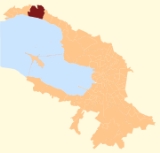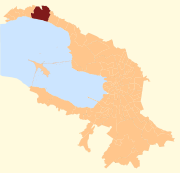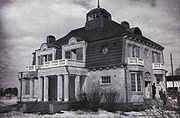
Zelenogorsk, Saint Petersburg
Encyclopedia



Kurortny District
Kurortny District is a district of Saint Petersburg, Russia, located on the Karelian Isthmus along the northern shore of the Gulf of Finland. Population:...
of the federal city
Federal cities of Russia
The Russian Federation is divided into 83 federal subjects, two of which are federal cities....
of Saint Petersburg
Saint Petersburg
Saint Petersburg is a city and a federal subject of Russia located on the Neva River at the head of the Gulf of Finland on the Baltic Sea...
, Russia
Russia
Russia or , officially known as both Russia and the Russian Federation , is a country in northern Eurasia. It is a federal semi-presidential republic, comprising 83 federal subjects...
, located in part of the Karelian Isthmus
Karelian Isthmus
The Karelian Isthmus is the approximately 45–110 km wide stretch of land, situated between the Gulf of Finland and Lake Ladoga in northwestern Russia, to the north of the River Neva . Its northwestern boundary is the relatively narrow area between the Bay of Vyborg and Lake Ladoga...
on the shore of the Gulf of Finland
Gulf of Finland
The Gulf of Finland is the easternmost arm of the Baltic Sea. It extends between Finland and Estonia all the way to Saint Petersburg in Russia, where the river Neva drains into it. Other major cities around the gulf include Helsinki and Tallinn...
, and a station on the St. Petersburg-Vyborg railroad. It is located about 50 kilometres (31.1 mi) northwest of central Saint Petersburg. Population:
Following the Finnish War
Finnish War
The Finnish War was fought between Sweden and the Russian Empire from February 1808 to September 1809. As a result of the war, the eastern third of Sweden was established as the autonomous Grand Duchy of Finland within the Russian Empire...
and until 1917, Terijoki was part of the Grand-Duchy of Finland, ruled by the Grand Dukes of Finland, who were the Tsars of Russia, (1812–1917).
Even though all of Finland was part of the Russian Empire
Russian Empire
The Russian Empire was a state that existed from 1721 until the Russian Revolution of 1917. It was the successor to the Tsardom of Russia and the predecessor of the Soviet Union...
, a customs border was located at Terijoki. A valid Passport was needed for crossing the border between Russia and the Grand Duchy of Finland.
Vladimir Lenin
Vladimir Lenin
Vladimir Ilyich Lenin was a Russian Marxist revolutionary and communist politician who led the October Revolution of 1917. As leader of the Bolsheviks, he headed the Soviet state during its initial years , as it fought to establish control of Russia in the Russian Civil War and worked to create a...
managed to travel over the border in secrecy to Finland in 1907. Later on 3 April 1917, he returned through the Terijoki border control disguised as a heater of a Finnish Railways - Finlyandsky Rail Terminal locomotive
Locomotive
A locomotive is a railway vehicle that provides the motive power for a train. The word originates from the Latin loco – "from a place", ablative of locus, "place" + Medieval Latin motivus, "causing motion", and is a shortened form of the term locomotive engine, first used in the early 19th...
.
With completion of the Riihimäki-St. Petersburg railroad in 1870, Terijoki become a popular summer resort, and was frequented by St. Petersburg's upper class until closure of the border during the Russian Revolution (1917).
When the Republic of Finland
Finland
Finland , officially the Republic of Finland, is a Nordic country situated in the Fennoscandian region of Northern Europe. It is bordered by Sweden in the west, Norway in the north and Russia in the east, while Estonia lies to its south across the Gulf of Finland.Around 5.4 million people reside...
gained independence on 6 December 1917, Terijoki became a part of it, and remained so until it was occupied by the Soviet Union
Soviet Union
The Soviet Union , officially the Union of Soviet Socialist Republics , was a constitutionally socialist state that existed in Eurasia between 1922 and 1991....
during the Winter War
Winter War
The Winter War was a military conflict between the Soviet Union and Finland. It began with a Soviet offensive on 30 November 1939 – three months after the start of World War II and the Soviet invasion of Poland – and ended on 13 March 1940 with the Moscow Peace Treaty...
(1939-1940). It was regained by Finland in 1941 during the Continuation War
Continuation War
The Continuation War was the second of two wars fought between Finland and the Soviet Union during World War II.At the time of the war, the Finnish side used the name to make clear its perceived relationship to the preceding Winter War...
(1941-1944), but then was then occupied again by the Red Army
Red Army
The Workers' and Peasants' Red Army started out as the Soviet Union's revolutionary communist combat groups during the Russian Civil War of 1918-1922. It grew into the national army of the Soviet Union. By the 1930s the Red Army was among the largest armies in history.The "Red Army" name refers to...
during the later stages of the same war and anexed to the Soviet Union in 1944.
During the Winter War
Winter War
The Winter War was a military conflict between the Soviet Union and Finland. It began with a Soviet offensive on 30 November 1939 – three months after the start of World War II and the Soviet invasion of Poland – and ended on 13 March 1940 with the Moscow Peace Treaty...
Terijoki become known as the seat of Otto Ville Kuusinen
Otto Ville Kuusinen
Otto Wilhelm Kuusinen was a Finnish-born Soviet politician, literary historian, and poet, who, after the defeat of the Reds in the Finnish Civil War, fled to the Soviet Union, where he worked until his death.- Early life :Kuusinen was born to the family of village tailor Wilhelm Juhonpoika...
's Finnish Democratic Republic
Finnish Democratic Republic
The Finnish Democratic Republic was a short-lived government dependent on and recognised only by the Soviet Union. It nominally operated in those parts of Finnish Karelia that were occupied by the Soviet Union during the Winter War....
.
After the Second World War its original Finnish population was displaced by people moved from Russia. At the turn of the century, the town's population was estimated to have been a few thousand, rising to above 50,000 in summer.
As of the beginning of the 21st century Zelenogorsk is actively developing in many directions. Various actions for improvement of quality of life and rest in Zelenogorsk have been carried out.
July 25 is the date of the annually celebrated City Day. On this day in 2009 a fountain was opened in the central square of the city park, and a sculpture named "Boots of the Traveller" was solemnly unveiled along the central avenue.
At the Dachshund monument, parades of dachshund
Dachshund
The dachshund is a short-legged, long-bodied dog breed belonging to the hound family. The standard size dachshund was bred to scent, chase, and flush out badgers and other burrow-dwelling animals, while the miniature dachshund was developed to hunt smaller prey such as rabbits...
s have been held, and the museum of vintage vehicles has gained additional new exhibits.
At a concert in honor of City Day in 2009, known musicians, such as Music hall theatre of St. Petersburg, Edita Piekha
Edita Piekha
Edita Piekha is a French-born popular Soviet and Russian singer and actress of Polish descent. She was the third popular female singer, after Klavdiya Shulzhenko and Sofia Rotaru, to be named a People's Artist of the USSR ....
, and others, performed.
External links
- terijoki.spb.ru - Site with information about the history and the modern life of Zelenogorsk/Terijoki
- www.terijoki.fi - Information about the Finnish period of Terijoki and present Finnish Terijoki-activities

